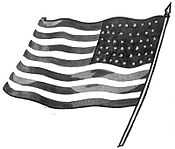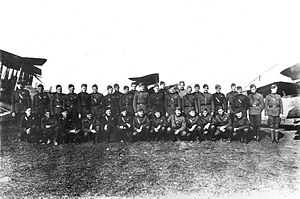I Corps Observation Group
| 1st Corps Observation Group | |
|---|---|
|
1st Aero Squadron, Julvecourt Aerodrome, France, November 1918 | |
| Active | 21 April 1918-15 April 1919 |
| Country |
|
| Branch |
|
| Type | Group |
| Role | Command and Control |
| Part of | American Expeditionary Forces (AEF) |
| Engagements |
|
| Insignia | |
| Identification symbol |
 1st Aero Squadron  12th Aero Squadron  50th Aero Squadron |
The I Corps Observation Group was an Air Service, United States Army unit that fought on the Western Front during World War I as part of the Air Service, First United States Army. It was demobilized in France after the 1918 Armistice with Germany on 15 April 1919.
There is no modern United States Air Force or Air National Guard unit that shares its lineage and history.
Mission
The mission of the group was primarily to keep the friendly command informed of the general situation within the enemy lines by means of visual and photographic reconnaissances. It was called upon to effect, whenever necessary, the adjustment of U.S. Army artillery fire. In addition, it was expected that the group would serve to complete the schooling of pilots and observers and render them more competent to undertake intensive operations elsewhere on a larger and more complete scale.
History
Organized in April 1918 as 1st Corps Observation Group. The assigned 1st Aero Squadron was the first American air unit to ever see action in France, being the same unit which served under General John J. Pershing as part of the Pancho Villa Expedition while chasing Pancho Villa into Mexico in 1916.
Assigned to the I Corps, United States Army Air Service, First United States Army. Commenced active operations over the front occupied by the 26th Division, United States Army, between Flirey and Apremont on that portion of the front known as the Toul sector.
The pilots of these squadrons, with one or two exceptions, had never before flown in combat. The group and squadron commanders were in every case men of long experience in training work but had never flown to an appreciable extent under war conditions.
The mission of the group was primarily to keep the friendly command informed of the general situation within the enemy lines by means of visual and photographic reconnaissances. It was called upon to effect, whenever necessary, the adjustment of our own artillery fire. In addition, it expected that the group would serve to complete the schooling of pilots and observers and render them more competent to undertake intensive operations elsewhere on a larger and more complete scale.
Lineage
- Organized in France as: I Corps Observation Group, 21 April 1918
- Demobilized in France on 15 April 1919
Assignments
- Headquarters Air Service, I Corps, First Army, 21 April 1918-15 April 1919
Components
- 1st Aero Squadron (Corps Observation), 6 April– 18 November 1918
- 12th Aero Squadron (Corps Observation), 30 April 1918-20 November 1918
- 50th Aero Squadron (Corps Observation), 14 August 1918-2 April 1919
- Photographic Section No. 1, Apr–Nov 1918
- N.211 Escadrille, Aéronautique Militaire (Attached), Apr–Nov 1918
Stations
|
|
See also
References
![]() This article incorporates public domain material from websites or documents of the Air Force Historical Research Agency.
This article incorporates public domain material from websites or documents of the Air Force Historical Research Agency.
- Series "D", Volume 2, List of Air Service Units Assigned to Tactical Operations and Table Showing Change of Stations for Air Service Units assigned to Armies before 11 November 1918. Gorrell's History of the American Expeditionary Forces Air Service, 1917–1919, National Archives, Washington, D.C.
- usaworldwar1.com – 1st Observation Group
- The American Army in the World War, A Divisional Record Of The American Expeditionary Forces in Europe, G Waldo Browne, Rosencrans W. Pillsbury, 1921, Overseas Book Co, Manchester, New Hampshire.
See also
| Wikimedia Commons has media related to I Corps Observation Group. |
| ||||||||||||||||||
